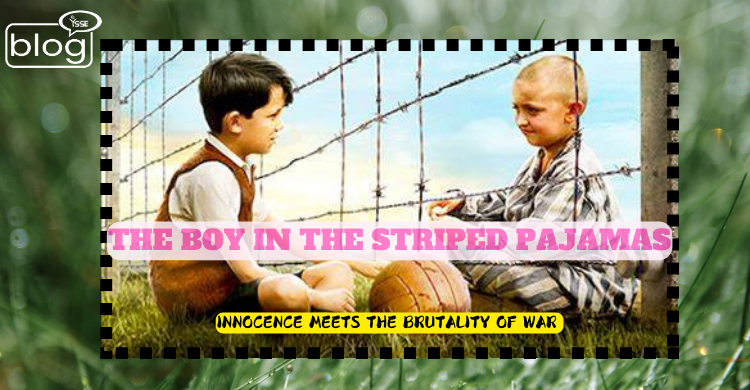The Boy in Striped Pajamas by John Boyne is an emotional story that juxtaposes the innocence of childhood with the terrible horrors of war. The Holocaust makes for a backdrop against which the novel offers an improbable tale of two boys on either side of a barbed-wire fence. The son of a Nazi officer named Bruno is the protagonist while Shmuel- a Jewish prisoner- is his friend.
The book’s childish lens paints the adult world more black and white than colored by its inhumanity in war and their impact on innocent lives.
A Simple Perspective on a Complex Reality
The story is told from the viewpoint of Bruno, an eight-year-old boy who does not understand much but uproots himself quickly when his father is made commandant of a concentration camp, mispronouncing it as ‘Out-With.’ Bruno’s view of the camp is that it’s just a gathering of strange people in striped pajamas. His innocence stands mighty and stark against the brutal realities lurking just outside the fence.
Boyne’s strategy of telling the story through the narrow-eyed window provokes the audience into such a dilemma by subjecting the act, the characters, and this small child to face the act with all innocence, as much as the narrative is haunting and heartbreakingly simple.
Friendship and Innocence
This is a story about friendship. Bruno and Shmuel have a relationship that goes beyond the barriers the world has put up around them; they would never have been brought together otherwise as functions of the circumstances into which they were born. Their conversations- one between an ignorant Bruno and a cautiously honest Shmuel—give poignant testimony to the humanity that war seeks to erase.
Bruno’s innocence is the last link that can be severed to reach the novel’s tragic ending, for Bruno’s innocent trust and loyalty ultimately lead him to cross the fence, an act that seals his soul and draws that of the other boys.
Innocence through War
One of the major assets of this novel is the idea of how war affects all innocence. Bruno’s family, especially his father, although being collaborators in the crime of the Holocaust, in no way makes Bruno take up the Nazi ideologies that currently rule in that period. Testifying the natural purity of the mind of a child.
On the contrary, Shmuel represents just a fraction of the endless and innocent victims the war leaves behind. His frailty, coupled with sadness and fear, bears such a vast contrast to Bruno’s life-grounded vitality and innocence.
Though the mother and sister of Bruno are not as responsible as his father, they too remain complicit in silence and inaction. First and foremost, this adds complexity to the narrative. Moreover, it shows how war is not confined to soldiers. It ensnares families and societies too.
Criticism and Controversy
The emotional depth and storytelling in The Boy in the Striped Pajamas make it quite popular, but it has also drawn criticism, mostly from Holocaust historians and educators. The critics claim that the story simplistically presents the Holocaust, an unrealistic representation of concentration camps and relationships between prisoners and Nazis.
For instance, historians claim that a young Jewish boy, like Shmuel, could not have moved freely and interacted with Bruno near a fence. Furthermore, this story would trivialize the Holocaust by bearing a German child’s perspective rather than that of its hundreds of thousands of Jewish victims.
The strength of the novel, nevertheless, lies in the ability to arouse empathy and reflection among younger readers. It has incited discussion on such issues as the Holocaust, prejudice, and the effects of the war.
The Heartbreaking Climax
At the end of the moving story, Bruno, showing allegiance to his friend, wears the striped pajamas, sneaks into the camp, and joins Shmuel to look for his father. Ignorant of what the gas chambers really do, the two youngsters tragically find themselves victims of the genocide machinery.
Such an ending, though purely fiction, could bring to mind the relentless cruelty that wars are capable of executing. Moreover, the image of two boys holding hands as they face their untimely fate would leave much more impact as it captures the novel’s message relative to adulthood and the price of hatred.
It is indeed not a narrative but, very much like the compulsion to look backward into history to prevent such awfulness from happening again.
To read more blogs like this, click here.
Writer,
Humyara Yeasmin
Intern,
Content Writing Department,
YSSE.

